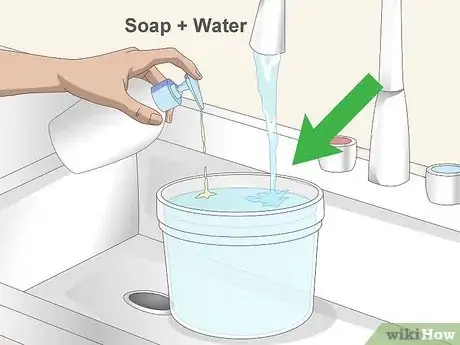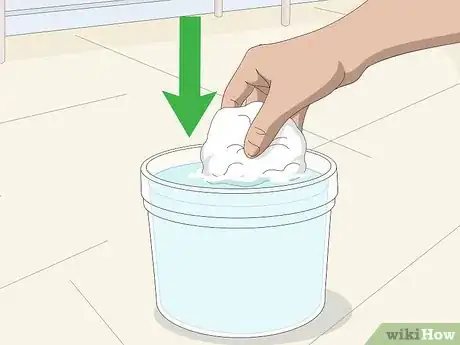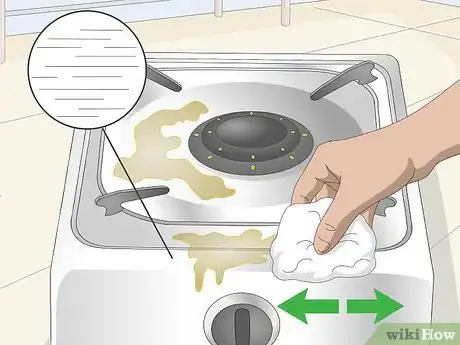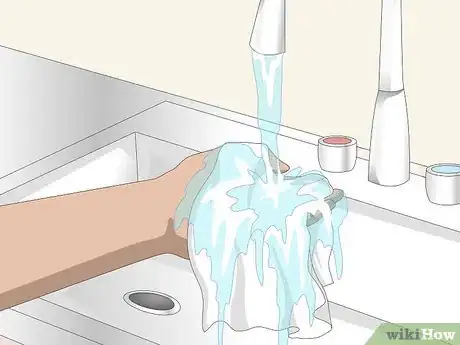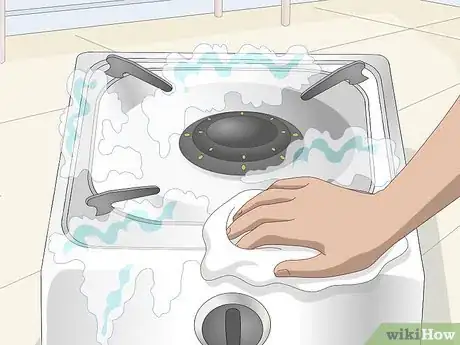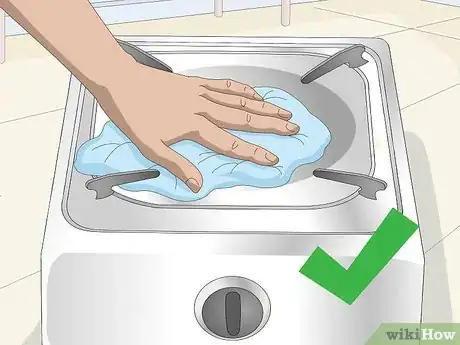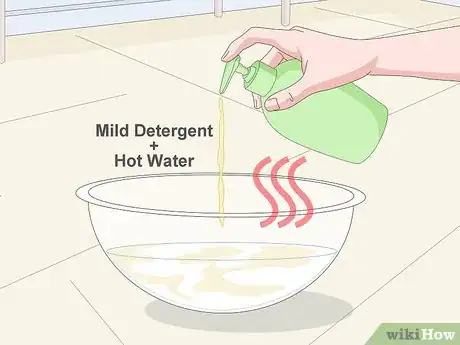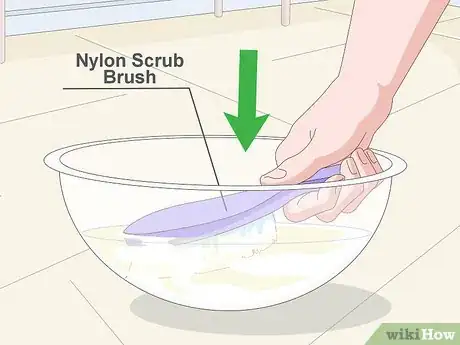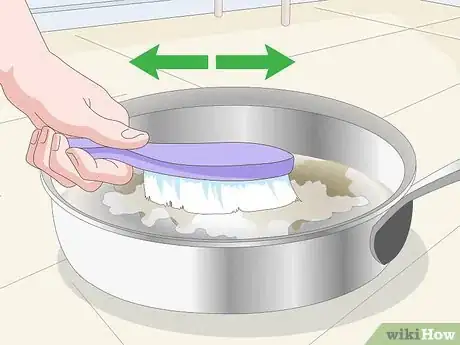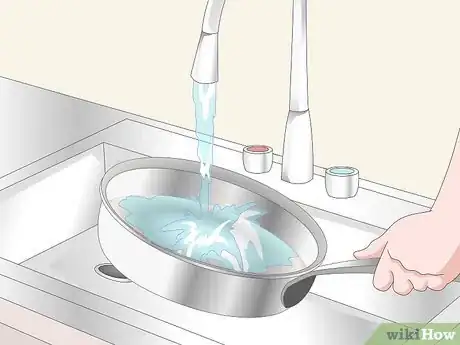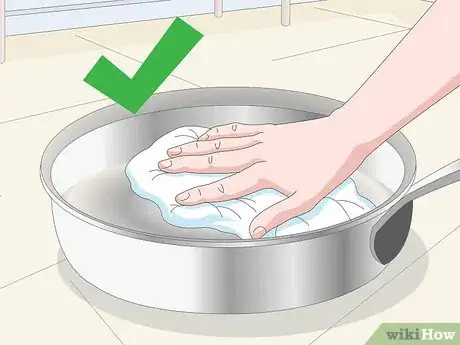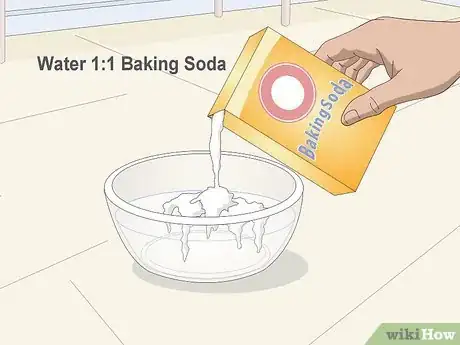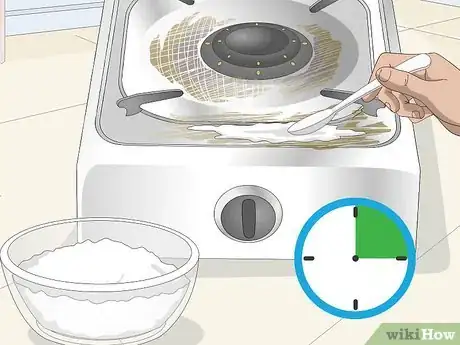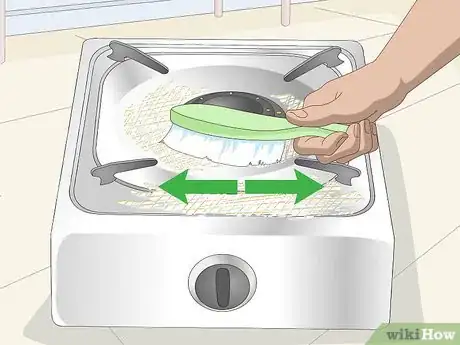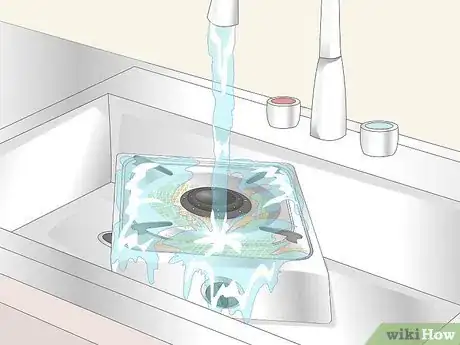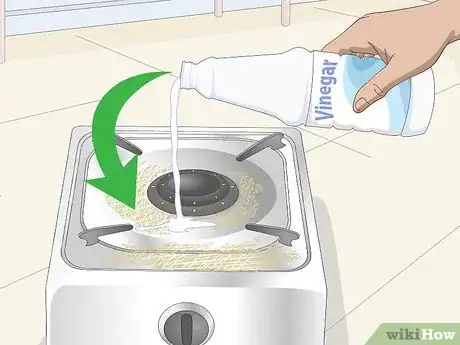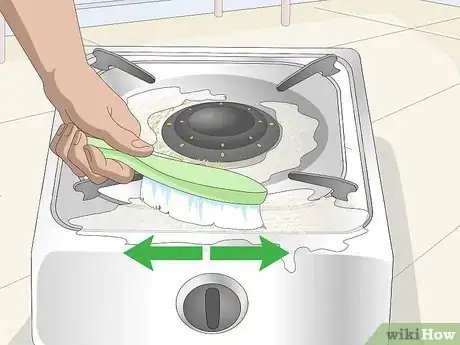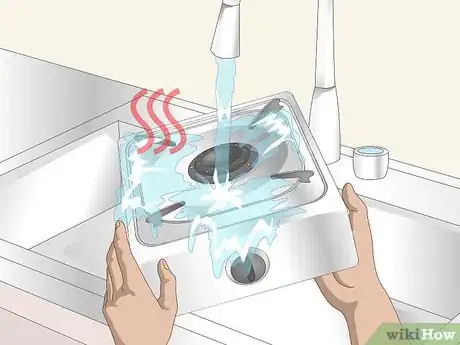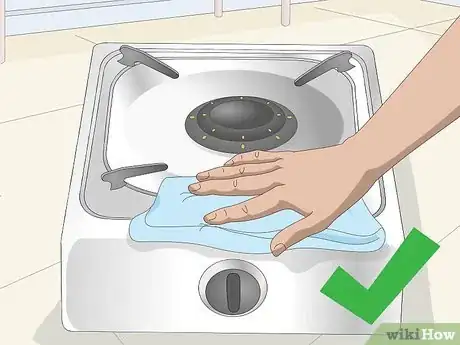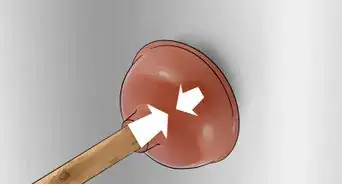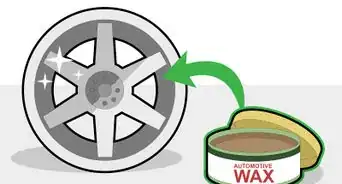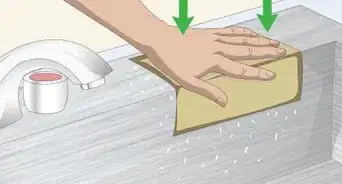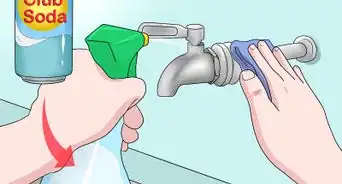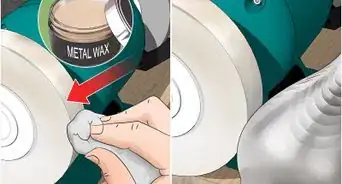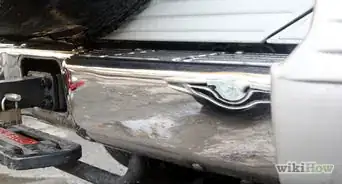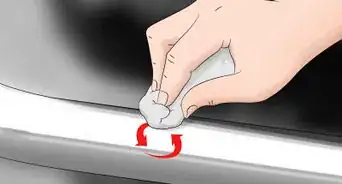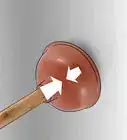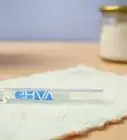This article was co-authored by Susan Stocker. Susan Stocker runs and owns Susan’s Green Cleaning, the #1 Green Cleaning Company in Seattle. She is well known in the region for outstanding customer service protocols — winning the 2017 Better Business Torch Award for Ethics & Integrity —and her energetic support of green cleaning practices.
wikiHow marks an article as reader-approved once it receives enough positive feedback. In this case, 94% of readers who voted found the article helpful, earning it our reader-approved status.
This article has been viewed 137,836 times.
Stainless steel is a tremendous tool. Many commercial settings use stainless steel products, but the resistance to moisture and bacteria means you can get a lot of value out of these products at home, too. Stainless steel appliances are easy to clean, benefitting from immediate washing with dish soap and water. Most grease will come off this way, although heavier stains require scrubbing and additional cleaners. To clean grease off stainless steel, first wash with soap and water, scrub with a nylon brush along the steel's grain, then apply baking soda and vinegar for the toughest stains, and finally rinse off any cleaner and dry the steel to prevent water stains.
Steps
Cleaning Before Grease Settles
-
1Mix soap and water. The mixture can be made in the sink while you're washing dishes. Simply mix a squirt of liquid dish detergent with some water until you have a bubbly cleaner. The soapy water won't harm stainless steel surfaces or appliances.[1]
- Commercial products such as Barkeeper's Friend, Cerama Bryte, Sprayaway, and Weiman are also non-abrasive cleaners that work well on stainless steel.[2]
-
2Dip a soft washcloth into the soapy water. Pick up the soapy water using the cloth. A sponge can be used instead as long as it isn't an abrasive scrubber. Any abrasive scrubber can end up scratching the steel.Advertisement
-
3Wipe the steel surface in the direction of the grain. Look closely at the stainless steel. You'll notice that its particles form lines going in a certain direction. For example, your steel object will have lines going up and down or left and right. Move the cloth along those lines.[3]
- When using soft cloths and soapy water, you aren't likely to scratch the surface if you make a mistake, but it's a good idea to always try to clean stainless steel along the grain.
-
4Rinse the same cloth with water. After soaping up the stainless steel, place the same cloth you used under the faucet. Run warm water over it to clear off the soap.[4]
-
5Wash the soap off the steel. Take the rinsed cloth and wipe it over the surface of the stainless steel to remove the soap. Remember to wipe along the grain.
-
6Dry the surface with a fresh cloth. A clean, soft cloth such as a terrycloth towel will do. Wipe it along the grain to remove the moisture and prevent water stains.[5]
Tackling Heavier Grease
-
1Mix a mild detergent in hot water. Empty the sink or get a clean bowl. Fill it with hot water, then add a squirt of a liquid detergent. Mix in the detergent to create soapy water.[6]
- Mild detergents are those such as Palmolive and Dawn that don't have abrasive qualities.
-
2Dip a nylon scrub brush into the mixture. A nylon brush for dish cleaning is soft enough to avoid scratching the steel. Dip it into the soapy water.
- If you are worried about the brush scratching the steel, you can try to apply the cleaner using a soft cloth, sponge, or non-scratch scouring pad such as a Scotch-Brite.[7]
-
3Scrub the greasy surface. Again, remember to take a close look at the surface of your stainless steel. If you can see the grain forming lines, scrub along those lines. This keeps the brush from scratching the steel.[8]
-
4Rinse the scrubbed surface. Place the appliance under warm running water if possible or use a soft cloth. The scrub brush will dislodge the grease, and the water will rinse away the grease and soap. Use the cloth to wipe along the grain and remove the soap.[9]
-
5Dry the surface with a towel. Use a clean, soft cloth and move it along the grain. Make sure you remove all the moisture so that the stainless steel doesn't get a water stain.
Removing Stubborn and Burnt Grease Stains
-
1Mix baking soda and water. In a bowl, combine equal parts baking soda and water. Mix the two together until they form a paste.[10]
-
2Rest the mixture on the stained area for 15 minutes. Apply the baking soda mixture by spreading it with a spoon or soft cloth without scrubbing it into the steel. Come back after 15 minutes.
-
3Scrub the stain using a nylon brush. An old toothbrush will suffice if you don't have a nylon brush. Remember the orientation of the steel's grain and scrub back and forth along it.[11]
-
4Rinse off the surface. Place the stainless steel under warm, running water if possible or use a damp cloth to remove the baking soda cleaner. Check to see if the stain has gone away.
-
5Pour vinegar over the stain. If the stain persists, pour vinegar straight from the bottle. Vinegar is acidic and can help remove the stain, so use the undiluted variety for the best results.
- When working with pots and pans, you can also try adding a half a cup of water and a sprinkle of baking soda to the vinegar before heating the mixture to a simmer on the stove for 20 minutes.[12]
-
6Scrub the stain again. Use your nylon brush or old toothbrush to move along the grain. Be gentle to avoid causing scratches.[13]
-
7Rinse off the vinegar. Again, place the stainless steel under warm, running water or use a damp cloth to remove all of the vinegar once you are done scrubbing. The stain should be minimized or removed.
-
8Dry the steel with a soft towel. Wipe away all the moisture using a terrycloth or microfiber towel. Make sure all the moisture is gone so it doesn't leave water stains.[14]
Expert Q&A
-
QuestionWhat is the best degreaser for stainless steel?
 Susan StockerSusan Stocker runs and owns Susan’s Green Cleaning, the #1 Green Cleaning Company in Seattle. She is well known in the region for outstanding customer service protocols — winning the 2017 Better Business Torch Award for Ethics & Integrity —and her energetic support of green cleaning practices.
Susan StockerSusan Stocker runs and owns Susan’s Green Cleaning, the #1 Green Cleaning Company in Seattle. She is well known in the region for outstanding customer service protocols — winning the 2017 Better Business Torch Award for Ethics & Integrity —and her energetic support of green cleaning practices.
Green Cleaning Expert Try Ecos Stainless Steel Polish or deionized water. Ecos Stainless Steel Polish is one of the best cleaners out there, and deionized water is a strong, chemical-free option that doesn't leave streaks.
Try Ecos Stainless Steel Polish or deionized water. Ecos Stainless Steel Polish is one of the best cleaners out there, and deionized water is a strong, chemical-free option that doesn't leave streaks.
Warnings
- Chlorine bleach and chloride products cannot be used on stainless steel.⧼thumbs_response⧽
- Abrasive scrubbing pads cause scratches. Steel scrubbers leave particles that rust.⧼thumbs_response⧽
- Very hard or gritty water stains stainless steel.⧼thumbs_response⧽
- Oven cleaners also damage stainless steel.⧼thumbs_response⧽
Things You'll Need
- Hot water
- Mild liquid dish detergent
- Nylon scrub brush
- Vinegar
- Baking soda
- Terrycloth towels
References
- ↑ http://www.ssina.com/download_a_file/cleaning.pdf
- ↑ http://cleanmyspace.com/how-to-clean-the-bottom-of-a-pot-or-pan/
- ↑ https://www.webstaurantstore.com/guide/542/how-to-clean-stainless-steel.html
- ↑ https://www.bobvila.com/articles/how-to-clean-stainless-steel/
- ↑ https://learn.compactappliance.com/clean-stainless-steel-appliances/
- ↑ https://www.bobvila.com/articles/how-to-clean-stainless-steel/
- ↑ http://www.ssina.com/download_a_file/cleaning.pdf
- ↑ https://www.webstaurantstore.com/guide/542/how-to-clean-stainless-steel.html
- ↑ https://www.bobvila.com/articles/how-to-clean-stainless-steel/
- ↑ http://groovygreenlivin.com/how-to-clean-stainless-steel-pots-and-pans/
- ↑ https://www.bobvila.com/articles/how-to-clean-stainless-steel/
- ↑ http://groovygreenlivin.com/how-to-clean-stainless-steel-pots-and-pans/
- ↑ https://www.webstaurantstore.com/guide/542/how-to-clean-stainless-steel.html
- ↑ https://learn.compactappliance.com/clean-stainless-steel-appliances/
About This Article
While most grease will come off stainless steel with some dish soap and water, heavier stains may need scrubbing and additional cleaners. Before the grease settles in, mix soap and water in a container, dip a soft washcloth or nonabrasive sponge into it, and wipe the steel surface in the direction of the grain. Finish by rinsing the cloth and wiping the steel surface off with clean water. For heavier grease, mix a mild soap with hot water, then dip a nylon scrub brush into the soapy water and scrub along the grain lines. You can also mix equal parts baking soda and water to form a paste, which you can spread onto the stained area. After 15 minutes, scrub the stain with a nylon brush or an old toothbrush. When you’re done, rinse the area clean with warm water. To learn how to use vinegar to clean stubborn grease stains off of stainless steel, keep reading!
